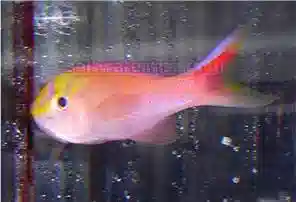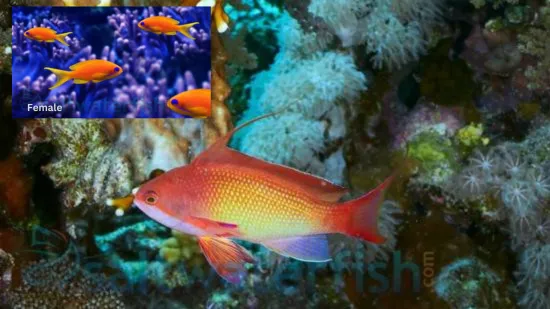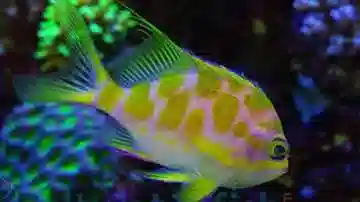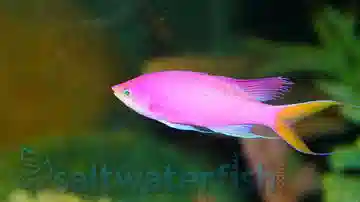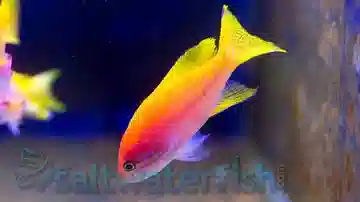Bimaculatus Anthias
Pseudanthias bimaculatus
(1 Reviews)

Bimaculatus Anthias
Pseudanthias bimaculatus
(1 Reviews)
{{ item.name }}
Size: {{ item.extra_field_3 }}
${{ getFormattedPrice(item.saleprice) }} ${{ getFormattedPrice(item.price) }}
To join the waiting list, click here
Free Shipping
With
$199.00
or more in Marine Life.
More details...
Bimaculatus Anthias Care Facts
| Care Level: | Moderate |
|---|---|
| Temperament: | Peaceful |
| Diet: | Carnivore |
| Reef Safe: | Yes |
| Minimum Tank Size: | 75 gallons |
| Max Size: | 5 inches |
The Bimaculatus Anthias (Pseudanthias bimaculatus): A Splash of Color in Your Reef
The Bimaculatus Anthias (Pseudanthias bimaculatus) is a fascinating and vibrant marine fish species that has gained popularity among saltwater aquarium enthusiasts. This product description will provide comprehensive information about keeping these remarkable fish in your saltwater marine aquarium.Habitat and Natural Range of the Bimaculatus Anthias
The Bimaculatus Anthias is native to the Western Pacific Ocean and can be found in coral-rich reefs and rocky outcrops. These fish typically inhabit depths ranging from 10 to 60 meters, making them well-suited for the reef environment.
Reef Compatibility of the Bimaculatus Anthias
This species is considered reef-safe, making it a great addition to your coral reef aquarium. Bimaculatus Anthias are not known to harm corals or invertebrates, making them an excellent choice for a mixed reef setup.
Size and Lifespan of the Bimaculatus Anthias
Bimaculatus Anthias are relatively small fish, with an average adult size of about 5 inches (12 cm). In captivity, with proper care, they can live for 5 to 7 years, providing aquarists with years of enjoyment.
Diet in Captivity for the Bimaculatus Anthias
These fish are carnivorous and primarily feed on zooplankton and small crustaceans in the wild. In captivity, it's essential to replicate their natural diet by offering a variety of high-quality frozen and live foods, such as brine shrimp, mysis shrimp, and copepods. Regular feeding is necessary to maintain their health and vibrant coloration.
Aquaculture and Availability of the Bimaculatus Anthias
The Bimaculatus Anthias are occasionally available through aquaculture efforts, though they may be less common than other species. Availability can vary depending on your location and the stock at your local fish store. It's essential to source them from reputable suppliers who prioritize sustainability.
Compatibility with Other Fish and Invertebrates for the Bimaculatus Anthias
Bimaculatus Anthias are generally peaceful and coexist with other reef-safe fish and invertebrates. However, it's crucial to avoid aggressive or overly territorial species that may harass them. They thrive in the company of their kind and should be kept in small groups consisting of one male and several females.
Sexual Dimorphism of the Bimaculatus Anthias
Male Bimaculatus Anthias exhibit more vibrant and striking coloration than females. Males have a bright red-orange body with two distinct blue spots on their dorsal fin. Females are generally paler in color and lack the intense hues seen in males.
Juvenile to Adult Coloration Changes of the Bimaculatus Anthias
As Bimaculatus Anthias mature, their coloration becomes more pronounced. Juveniles may display less vibrant colors, but they will develop their full adult colors as they age.
Temperament of the Bimaculatus Anthias
These fish are generally peaceful and non-aggressive, making them suitable for community aquariums. However, they can be somewhat shy, so providing plenty of hiding spots and live rock formations can help them feel secure.
Tank Requirements for the Bimaculatus Anthias
Creating the right environment is crucial for the well-being of your Bimaculatus Anthias. Here are the critical tank requirements:
Minimum Aquarium Size:
A tank with a minimum capacity of 75 gallons is suitable for a small group of Bimaculatus Anthias.Water Conditions:
- pH: Maintain a stable pH level between 8.1 and 8.4.
- Salinity: Keep the salinity levels at 1.023 to 1.025.
- Water Temperature: Maintain a temperature range of 75 to 80°F (24 to 27°C).
- Water Flow: Moderate to strong water flow can mimic their natural reef habitat.
Other Common Names for the Bimaculatus Anthias
The Bimaculatus Anthias may also be called the "Two-spot Anthias" or simply the "Bimac Anthias."
Compatible Tank Mates for the Bimaculatus Anthias
Here are five suitable tank mates for the Bimaculatus Anthias:
- Purple Firefish (Nemateleotris decora): These small, peaceful fish add elegance to your tank and get along well with Bimaculatus Anthias.
- Royal Gramma (Gramma loreto): Known for their striking purple and yellow colors, Royal Grammas are generally peaceful and make excellent companions.
- Fire Shrimp (Lysmata debelius): These colorful shrimp are reef-safe and can help with aquarium cleanup.
- Cleaner Wrasse (Labroides dimidiatus): They provide a valuable service by cleaning parasites from other fish and are generally compatible with Bimaculatus Anthias.
- Coral Banded Shrimp (Stenopus hispidus): These striking shrimp can be kept with Bimaculatus Anthias, provided they have ample hiding spots.
Why Buy Bimaculatus Anthias from Saltwaterfish.com
When you purchase Bimaculatus Anthias from Saltwaterfish.com, you can trust that you are acquiring healthy and responsibly sourced specimens. Our commitment to sustainable practices ensures that you can enjoy these stunning fish while contributing to the preservation of our precious marine ecosystems.
In Conclusion
The Bimaculatus Anthias is an excellent choice for saltwater aquarium enthusiasts looking to add color, beauty, and vitality to their reef tanks. With proper care and attention to their specific needs, these fish can thrive in a well-maintained aquarium. Whether you're a beginner or an experienced hobbyist, the Bimaculatus Anthias is a captivating addition to any marine setup, and Saltwaterfish.com is your trusted source for acquiring them.
The Bimaculatus Anthias: Female are great fish. They acclimated very well. They are always out and swimming around. Their color changes under my lighting. Fun to watch.
Reviewed by: Max Didia on Sept. 11, 2021


